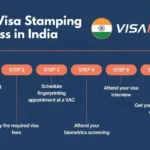Traveling to India can be a fantastic experience for families, and for US citizens, it’s essential to understand the visa requirements for minors and children. This article provides an overview of the process, types of visas available, and essential tips for a smooth application experience for children traveling to India.
Types of Indian Visas for Minors and Children
US citizens, including minors and children, need a visa to enter India. The type of visa required depends on the purpose of the visit. Here are the primary visa options suitable for minors:
E-Tourist Visa: The E-Tourist Visa is ideal for short-term visits, allowing stays of up to 30 days. This visa can be obtained online and is suitable for tourism, family visits, or short courses. Parents or guardians can apply on behalf of minors.
Regular Tourist Visa: If the planned stay exceeds 30 days or involves multiple entries, a Regular Tourist Visa is necessary. INDIAN VISA FOR US CITIZENS MINORS AND CHILDREN This visa allows longer stays (up to 180 days) and requires a more detailed application process.
Student Visa: For minors traveling to India for educational purposes, such as studying at an Indian school or attending courses, a Student Visa is required. This visa is issued for the duration of the academic program.
Entry Visa: This visa is often used for family reunification, allowing US citizens to join relatives living in India. It can be suitable for minors traveling to visit family members.
Application Process for Minors
E-Tourist Visa Application
Online Application: Parents or guardians can apply for an E-Tourist Visa for minors through the official Indian visa website. The online form will require the child’s details, including name, date of birth, and passport information.
Supporting Documents: Along with the online application, a recent passport-sized photograph and a scanned copy of the child’s passport’s bio page must be uploaded.
Payment: The visa fee can be paid online using a credit or debit card. The fee varies based on the visa type and duration of stay.
Approval: Upon approval, the E-Tourist Visa will be sent via email. Parents should print a copy to present upon arrival in India.
Regular Tourist Visa Application
In-Person Application: For a Regular Tourist Visa, the application must be made in person at the nearest Indian embassy or consulate. It’s advisable to schedule an appointment in advance.
Complete Application Form: Fill out the visa application form accurately, providing all required information about the child.
Gather Necessary Documents: Required documents typically include the child’s passport, a passport-sized photograph, a birth certificate (for age verification), and proof of travel arrangements.
Visa Fee Payment: The visa fee can usually be paid in cash or by card at the embassy or consulate.
Processing Time: Processing times for Regular Tourist Visas can vary, so it’s essential to apply well in advance of the planned travel date.
Important Considerations
Passport Validity: Ensure the child’s passport is valid for at least six months beyond the planned departure date from India and has at least two blank pages.
Traveling with Guardians: If the child is traveling without both parents, a notarized letter of consent from the non-traveling parent(s) may be required.
Health Regulations: Check for any health requirements or vaccinations that may be needed before traveling to India. WHICH AIRPORTS ALLOW ENTRY WITH INDIAN EVISA Travel Insurance: Consider purchasing travel insurance that covers minors for medical emergencies, trip cancellations, and other unforeseen events.
Conclusion
Obtaining an Indian visa for US citizens, including minors and children, involves understanding the different visa options and following the application procedures. Whether applying for an E-Tourist Visa for a short family vacation or a Regular Tourist Visa for a longer stay, parents can ensure a smooth process by preparing the necessary documents and applying in advance. By being well-informed, families can enjoy a memorable experience exploring the rich culture and heritage of India together.


